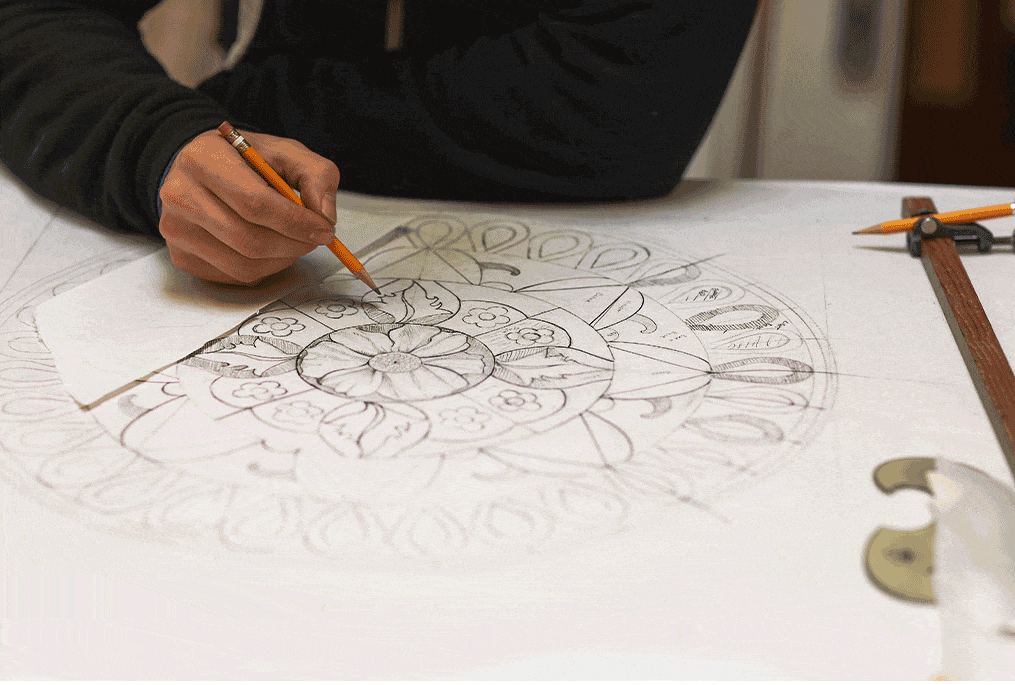Meet the newest print that's catching everyone's eye this season!
Stained Glass Medallion marries two of our hallmarks: medallion motifs and brilliant colors.

This fun pattern plays off of simple shapes with universal appeal to create a design unlike any other. The layers in Stained Glass Medallion tell a vibrant story — and represent a history that's instantly intriguing.
The deeply saturated hues and long-respected lines of stained glass have been admired since ancient Rome. From historical cathedrals in Europe to intricately crafted churches across America, this fine art has made its impression around the globe. Drawing on architectural elements makes stained glass patterns all at once familiar and exciting.
Our very own design for Stained Glass Medallion takes cues from most-loved pieces by legends like Harry Clarke, a 20th-century Irish artist. Developing a work of stained glass involves an eye for detail and extensive expertise in engineering such dynamic works.
We wanted to show how the steps come together — from creating the composition to scrubbing the surface — with a local stained glass artist from our hometown!

This fun pattern plays off of simple shapes with universal appeal to create a design unlike any other. The layers in Stained Glass Medallion tell a vibrant story — and represent a history that's instantly intriguing.
The deeply saturated hues and long-respected lines of stained glass have been admired since ancient Rome. From historical cathedrals in Europe to intricately crafted churches across America, this fine art has made its impression around the globe. Drawing on architectural elements makes stained glass patterns all at once familiar and exciting.
Our very own design for Stained Glass Medallion takes cues from most-loved pieces by legends like Harry Clarke, a 20th-century Irish artist. Developing a work of stained glass involves an eye for detail and extensive expertise in engineering such dynamic works.
We wanted to show how the steps come together — from creating the composition to scrubbing the surface — with a local stained glass artist from our hometown!


William L. Lupkin Designs helps restore and create stained glass pieces for religious, residential and commercial buildings. Commissions come in from across the country (and even across the ocean — the studio has done business with clients in Europe!). James works in his family's studio and helps craft these amazing works of art. You can follow along @williamlupkindesigns on Instagram.

First and foremost: James studies our Stained Glass Medallion pattern to develop a reference sketch. The drawing is made on tracing paper so that a carbon copy is also produced. Through the entire process, James looks to this sketch as a guide.


The sketch is color-coded (like a paint-by-numbers!) to accommodate all of the pattern's brilliant hues. James customizes every color: jewel-toned red, deep aqua and kelly green.
The production of the pieces relies on the precise combination of minerals and molten glass. By adding powdered elements (like using real cobalt for, well, cobalt blue), James is able to recreate the palette found in Stained Glass Medallion.



The tinted sheets of glass are measured and shaped. From straight edges to organic curves, glass cutters and pliers make the process appear effortless.
To enhance the design with smaller lines and shading, James mixes a blend of gum arabic binder, tracing powder and water. After this mixture is precisely painted, the glass is fired in a kiln so that the details are permanently preserved. The kiln temperature must be exactly right — too low and the pigments won't fuse, too high and the glass will "slump" as it meets its melting point.


James assembles the panel with strips of flexible, pliable lead. These lead components have H-shaped channels, or "hearts," for the glass pieces to interlock. The lead is snipped with special scissors that preserve the grooves in which the glass is wedged.
It's time to solder once the pieces are locked into the lead channels. This binds the lead together and solidifies the design.
The piece is almost done; however, James takes special steps to ensure the panel is weatherproof and able to gleam for years to come. Puttying, or painting on a mixture of materials that hardens over time, locks water out of the lead channels' grooves.
James polishes with a dry brush to shine the surface and remove any powders or pigments that were picked up along the way. The panel is now ready to be displayed — and treasured for a lifetime.

You can WIN this incredible, one-of-a-kind interpretation of Stained Glass Medallion! For the chance to call the panel yours, tag two friends on Instagram OR Facebook and tell us what you're so excited to celebrate this holiday season.


All in the family: Original art from William's sons ... who have grown up to work in the design studio with him!







